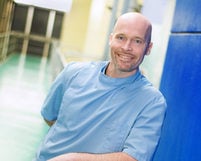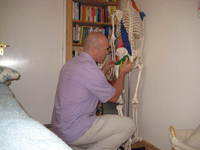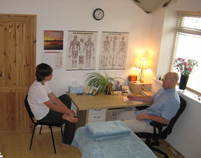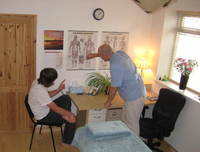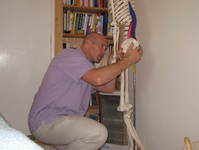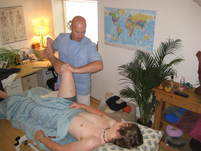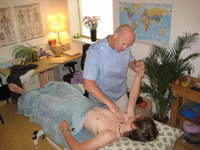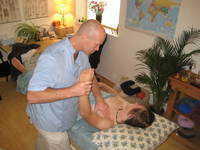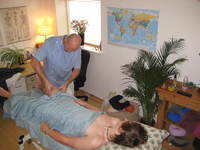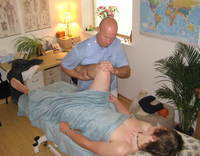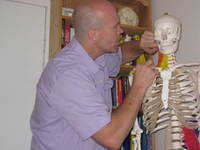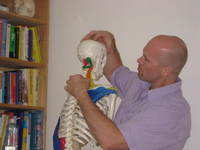Your first visit.
| Consultation, (first visit)
"I went to Darren after having other treatments such as Physiotherapy, Chiropractic, Acunpuncture, Anti Inflammatories and being put into traction, all of which failed. Since having treatment with Darren I have gone from being in pain 100% of the time to being pain free 99% of the time." Rob B. Stratton St Margaret Often, the most worrying part of considering treatment for pain relief is the very first visit. The chances are fairly good that you have been referred to me, which should allay some concerns, but if you haven’t been referred, or you still have some worries, read on.
I have tried to address worries about your first visit based on the concerns I would, and still do have, in the same situation. Although these concerns may often arrive simultaneously I’ve addressed them in the approximate order they may occur. Please click on the title you're most interested in, or scroll through and read it all! Current fees are in section 12 at the bottom of the page.
2. What do I do on arriving? Parking?
3. Will I get on with the practitioner?
4. Is he properly qualified/experienced?
5. How is he different from other practitioners I’ve seen?
7. What will happen during the first visit (consultation)?
10. How long will it take to fix my symptoms?
Here is a detailed map of my address, where my clinic is situated, at:- 2 Purbeck close, Nythe, Swindon, Wilts SN3 3RE Use the slider in the top left hand corner of the map to zoom in or out to see a more detailed picture. 2. What to do upon your arrival
Upon your arrival you will usually find ample parking, at 3pm however there is a local school pick up and pandamonium ensues for about 15 minutes. You will see my house, No. 2, with a dark green main door. The entrance to the waiting room is on the left with a plaque on the door. Usually my black Vivaro van is parked in the driveway. If you find there is no parking due to school or other reasons, please feel free to park directly in front of my van across the drive.
When you arrive please park up and go straight into the waiting room. There is no need to knock or ring the bell. Be assured that I will be expecting you. (as long as you've made an appointment of course)
If I’m running more than a few minutes late, I will always let you know on your arrival. There is a small toilet should you need it, and some interesting books/magazines to occupy you. There are also quotes and poems on the walls, copies of which are available in the green folder on the magazine shelf should any take your fancy.
I’m very lucky in being able to do a job that I enjoy and find very fulfilling. An enormous part of my work involves helping you to feel comfortable secure and confident in my ability to help you. Since we will be working together to ease and remove your pain it's essential that we get along. To date this has always been the case. I welcome and encourage questions and enquiries about every aspect of your treatment. A big part of the enjoyment of my job is the interaction with you, the patient.
If you would like to learn more about me follow this link : About Darren.
4. Is he qualified/ experienced?
The short answer is yes, on both counts.
I began 6 years of study in remedial manual therapy at Regents college in London in 1991 and graduated in 1997.
I began practising treatments at the end of 1993, after I gained a qualification in therapeutic massage. This training gave me valuable experience in working with people and strongly influenced the way I work today. By the time I graduated in 1997, I had been working for three years and had an established, if not large practice. To date, my practice has grown substantially, and entirely on word of mouth recommendations. In that time I’ve carried out thousands of treatments on people from the age of 6 months to 93 years including mothers and home workers, world class athletes, business leaders, manual workers, and desk workers. I’ve learned that everyone is different, and everyone is the same. I am also fully insured to practise.
5. How is he different from other practitioners, such as chiropractors, physiotherapists and sports massage therapists etc ?
The reality is that there are more similarities between all of these therapies, than disparities. The biggest differences are between individual practitioners, sometimes even between practitioners of the same therapy!
My early experience with massage, and the intense training and knowledge of manual therapy have helped me understand how muscles work and interact with each other, and how they interact with the other soft tissues of your body. I’ve learned how manipulation of the ‘soft tissues’, ie focused massage work can be extraordinarily powerful in resolving the most chronic symptoms, addressing essential factors that joint manipulation and exercise therapy can’t hope to address, whilst acknowledging that both of these therapies can have great impact. I now specialise in muscle dysfunction and rehabilitation, using various types of powerful and effective soft tissue release techniques.
In essence, I’m not different to everyone, but different to many, both in the way that I work, and the way I involve you the patient in the treatment. I don’t claim to have 100% success rate, I still have a lot to learn. I pride myself on the fact that I put you and your well being first and foremost, (see testimonials.) If I feel I can’t help you I will tell you as soon as I become aware of this. (usually within the first or second session) If not I will then refer you in an appropriate direction.
It may be important on your first visit, to observe your posture with you standing in your underwear (see: what happens in consultation). If you would feel more comfortable, please bring a short pair of shorts and/or swim wear. However I do appreciate that some people are self concious about taking their clothes off, and I'm happy to assess and treat you through clothing if that is your wish. If this is the case please wear loose soft clothing in the form of T shirts, leggings or track suit bottoms etc. Also a bra with rear fastening, rather than a sports bra is ideal. (ladies only!) For my part, I’ve now seen over three thousand people of both sexes, and all ages and sizes in their underwear, and there is little that will surprise me. I pride myself on being 100% professional. My interests are purely in observing skin, muscle action and joint movement that may help me to assess and relieve your pain.
Also you will need to bring or remember details of your medical history, ie accidents, operations, illnesses and details of any medications you are taking. If you have copies of X rays, or MRI reports please bring these as well.
7. What happens during the first visit. (consultation)?
I will collect you from the waiting room, and ask you to take a seat with me in the treatment room. We’ll begin with your case history, I’ll ask you about your pain, where it is, how long you’ve had it, how it affects your life, and if there is any pattern to it, etc. Then I’ll ask you about your medical history, any previous treatments you’ve had and how you reacted to them. I’ll also ask about any medical investigations you may have had such as MRI scans, x-rays and blood tests etc. I may also take your blood pressure reading. If you have a variety of symptoms, it can be very helpful if you write down a timeline of when the different problems appeared, this includes any disease or medical condition that you may have. Try and note also what medication you took or take, and when you started it. This usually takes between 15 and 30 minutes. With all the information you give me, I should have a fairly good idea of what’s causing your symptoms.
The next step is to confirm, deny or modify the assessment I’ve made from your case history by examining you. This involves observing your posture whilst you stand in your underwear, shorts or loose clothing or stretchy leggings. see what do I need to bring. While you get changed, I will leave the room to wash my hands.
Overall, I will be looking for clues to the cause of your pain. Even if you have a headache, I need to know if the arches of your feet have dropped, if your pelvis is level, if there are signs of stress on your spine that may be visible through changes in your skin colour and tension as well as countless other observations that may enable me to discover the cause of your symptoms.
I may then ask you to bend forwards, backwards sideways or even twist your body. All the time I’m looking for subtle or obvious dysfunctions in the way your spine, your joints and your muscles are working.
Depending on what symptoms you have, I may then ask you to sit or lay down on the treatment table (couch). When you lay down I will cover you with a large towel for the duration of the treatment only ever exposing the areas to be worked on and maintaining your dignity at all times.
While you are on the couch I will carry out a number of different tests designed to help me further refine my assessment, these tests may involve moving your joints passively while you relax, or asking you to resist certain levels of pressure upon your muscles and joints.
Throughout every step of the examination I will be telling you what I’m doing and why I’m doing it, as well as asking for your constant feedback. It is during this process that I want you to begin to realise how important your role is during treatment, it is always my intention that we resolve your symptoms as a team. I fully believe your body knows exactly what it needs to do or have done, in order to regain it's health, and ideally I want you to be able to tune into this extraordinary process, which is sometimes known as body intelligence/wisdom or intuition.
By the time we reach the end of the examination I should be 80-100% sure of what is causing your problem and I’ll move into the appropriate treatment. I will continue to learn more as I treat you based on what I feel and how you are reacting. This will usually confirm or allow me to modify my assessment and treatment as we go.
Sometimes treatment will be uncomfortable, the important thing to remember is that you are COMPLETELY in charge of this. There is a very good reason for the discomfort you may feel during treatment, and this is explained in the link :-What causes my pain? We will work together using a pain scale from one to ten which enables you to tell me exactly what level of discomfort you are experiencing, if that level becomes too high I will immediately and gently ease off to a more comfortable level. Often you will experience what is known as ‘good pain’ this goes back to your body intelligence telling you that although what’s being done is uncomfortable, it’s also helpful. 9. Will I have to do exercises?
I may give you some exercises, but more often than not I will give you self massage to do at home either using your own hands, elbow or forearm, or a tool such as a ball. It makes sense that if the treatment is making you better, why not continue it at home as directed. There are a number of reasons why exercises are often inappropriate for rehabilitation work, follow this link to find out more:- exercise therapy. 10. How long will it take to fix my symptoms?
In most cases it takes somewhere between 3 and 6 treatments to resolve painful conditions.
There is an old saying in the world of natural therapy that goes along the lines of ‘a good therapist sees very little of his patients’.
This is true of course, if the therapist is able to help the patient heal and reduce or remove their symptoms. In my practise if I am treating someone, I expect their condition to improve with every session, if there is absolutely no change after two, or at the most, three sessions, then I will not continue treatment.
Whilst I would love to be able to ‘fix’ everyone I see, its simply not possible. There are many reasons for this, most often there maybe an underlying cause such as pain caused by a ‘slipped’ disc, ( the correct term for this condition is a herniated or prolapsed disc). I may be able to reduce the patients symptoms but the damaged disc could still press painfully on the nerve root and symptoms will continue.
Another reason could be that some aspect of the patients lifestyle is continually reactivating the symptoms, this may be occupational posture, or sport, poor bed, pillows, or sofa, it may be long hours driving in a poor car seat or in a sitting for hours in a poor office chair. It may even be food/ digestion related (see nutrition and pain) or some other disease process.
On rare occasions, it may be that I have missed something in my initial assessment, if there is no improvement by the 3rd session I will fully re-assess to make sure this is not the case. If my findings remain the same and there is no improvement I will endeavour to refer you in a direction that may be more helpful. The majority of my patients are usually symptom free within 3-6 sessions.
I see many people on a more long term basis because their improvement with each session justifies continuing. It may be that they have a long term condition that will take time to heal, or an underlying condition that makes full resolution slow or improbable. With any case like this we will discuss the merits of continuing treatments on a session by session basis, and even then, only if there is some improvement. Sometimes for some people, it’s only this kind of work that will enable them to stay functional, where all other kinds of treatments have failed.
11. Will I need maintenance work?
I believe 100%, that the work I do will improve the health of your structure. To that end I often recommend maintenance treatment to prevent your symptoms reoccurring. In the majority of cases that I see, some aspect of lifestyle is the predominant cause of symptoms. It stands to reason that unless we change these aspects, (and they may be multiple) our symptoms will reoccur. Maintenance aims to prevent this. There is no guarantee, but the majority of people I see on a regular maintenance routine reduce substantially, or omit completely the return of symptoms. A maintenance programme will generally involve having a treatment regularly, 6 weeks to 3 months apart. Of course many people choose to come only when they feel they need treatment, and this is absolutely fine. First visit. £65.00 45 minute treatment. £60.00 30 minute treatment. £50.00
Cash or cheque only please. I have no card facilities. (which is true, but also I'm a grumpy old man who refuses to pay extra to credit card companies and banks, and dislikes having to find the passwords to open the bank to check whether people have paid or not.)
Please note that this is Remedial work, designed to assess and treat painful problems. Therefore the prices listed above are a guide only. The time taken for a treatment is determined by what needs to be done rather than how long you would like to be treated, so you may find that where you thought you would be in for 45 minutes, we only need to do half an hours work or vice versa, and the charge will reflect that. Of course we will discuss everything during the session. "........I wouldn’t hesitate to recommend Darren to anyone seeking relief from constant pain.My personal improvement has been, and continues to be immense." Judith B. Brinkworth. |
|



